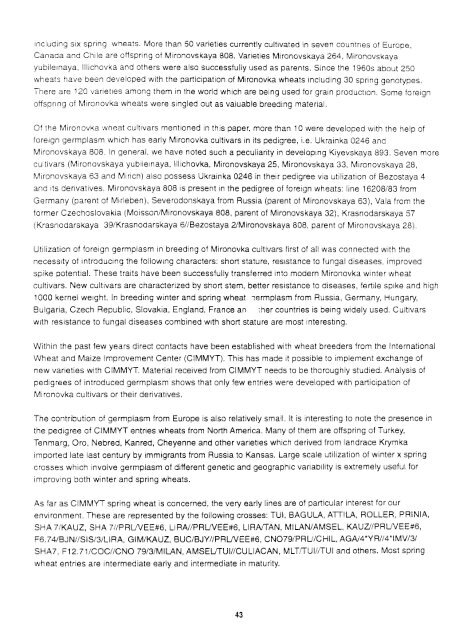Untitled - Search CIMMYT repository
Untitled - Search CIMMYT repository
Untitled - Search CIMMYT repository
Create successful ePaper yourself
Turn your PDF publications into a flip-book with our unique Google optimized e-Paper software.
including six spring wheats. More than 50 varieties currently cultivated in seven countries of Europe,Canada and Chile are offspring of Mironovskaya 808. Varieties Mironovskaya 264, MironovskayayUbilemaya, Illichovka and others were also successfully used as parents. Since the 1960s about 250wheats have been del/eloped with the participation of Mironovka wheats including 30 spring genotypes.There are 120 varieties among them in the world which are being used for grain production. Some foreignoffspring of Mironovka wheats were singled out as valuable breeding material.Of the Mironovka wheat cultivars mentioned in this paper, more than 10 were developed with the help offoreign germplasm which has early Mironovka cultivars in its pedigree, i.e. Ukrainka 0246 andMironovskaya 808. In general, we have noted such a peculiarity in developing Kiyevskaya 893. Seven morecultivars (Mironovskaya yubilelnaya, Illichovka, Mironovskaya 25, Mironovskaya 33, Mironovskaya 28,Mironovskaya 63 and Mirich) also possess Ukrainka 0246 in their pedigree via utilization of Bezostaya 4and its derivatives. Mironovskaya 808 is present in the pedigree of foreign wheats: line 16208/83 fromGermany (parent of Mirleben), Severodonskaya from Russia (parent of Mironovskaya 63), Vala from theformer Czechoslovakia (Moisson/Mironovskaya 808, parent of Mironovskaya 32), Krasnodarskaya 57(Krasnodarskaya 39/Krasnodarskaya 611Bezostaya 2/Mironovskaya 808, parent of Mironovskaya 28).Utilization of foreign germplasm in breeding of Mironovka cultivars first of all was connected with thenecessity of introducing the following characters: short stature, resistance to fungal diseases, improvedspike potential. These traits have been successfully transferred into modern Mironovka winter wheatcultivars. New cultivars are characterized by short stem, better resistance to diseases, fertile spike and high1000 kernel weight. In breeding winter and spring wheat lermplasm from Russia, Germany, Hungary,Bulgaria, Czech Republic, Slovakia, England, France an ;her countries is being widely used. Cultivarswith resistance to fungal diseases combined with short stature are most interesting.Within the past few years direct contacts have been established with wheat breeders from the InternationalWheat and Maize Improvement Center (<strong>CIMMYT</strong>). This has made it possible to implement exchange ofnew varieties with <strong>CIMMYT</strong>. Material received from <strong>CIMMYT</strong> needs to be thoroughly studied. Analysis ofpedigrees of introduced germplasm shows that only few entries were developed with participation ofMironovka cultivars or their derivatives.The contribution of germplasm from Europe is also relatively small. It is interesting to note the presence inthe pedigree of <strong>CIMMYT</strong> entries wheats from North America. Many of them are offspring of Turkey,Tenmarg, Oro, Nebred, Kanred, Cheyenne and other varieties which derived from landrace Krymkaimported late last century by immigrants from Russia to Kansas. Large scale utilization of winter x springcrosses which involve germplasm of different genetic and geographic variability is extremely useful forimproving both winter and spring wheats.As far as <strong>CIMMYT</strong> spring wheat is concerned, the very early lines are of particular interest for ourenvironment. These are represented by the following crosses: TUI, BAGULA, ATIILA, ROLLER, PRINIA,SHA 7/KAUZ. SHA 71IPRUVEE#6. URN/PRUVEE#6. URAfTAN, MILAN/AMSEL, KAUZlIPRUVEE#6,F6.74/BJN//SIS/3/L1RA, GIM/KAUZ. BUC/BJYIIPRUVEE#6, CN079/PRUICHIL, AGN4·YR/14·IMV/31SHA7, F12.71/COCIICNO 79/3/MILAN, AMSEUTUIIICUUACAN, MLTrrUl//TUI and others. Most springwheat entries are intermediate early and intermediate in maturity.43

















